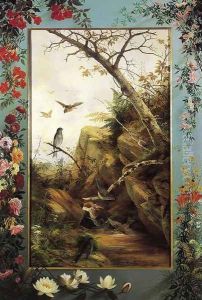Robert Wilkie Paintings
Robert Wilkie was a 19th-century American artist known for his genre paintings that often depicted scenes of everyday life in America. Born in 1828 in the United Kingdom, Wilkie immigrated to the United States as a child with his family. Settling initially in Buffalo, New York, he developed an interest in art at an early age. Wilkie's talent was recognized early on, and he began his formal training as an apprentice to an engraver.
Throughout his career, Wilkie was influenced by the prevailing artistic movements of his time, including the Hudson River School, whose emphasis on landscape painting and natural beauty can be seen in the backgrounds of some of his works. Despite the influence of the Hudson River School, Wilkie is best remembered for his genre scenes, which often captured the spirit of American life. His works were narrative and featured characters from a range of social classes, providing insight into the culture and customs of the time.
Wilkie's skill as an artist was matched by his knack for business. He was an active member of the art community and was involved in the establishment of art institutions and societies. His paintings were well-received, and he garnered a reputation that allowed him to sell his works to a broad audience, including middle-class Americans who were eager to purchase art that reflected their own experiences.
He continued to paint and exhibit his work throughout his life, with his paintings often reflecting the changing times and sentiments of the American people. Robert Wilkie passed away in 1903, having left behind a body of work that offers a window into the life and times of 19th-century America. Though not as widely recognized today as some of his contemporaries, his work remains an important part of the narrative of American art history.
